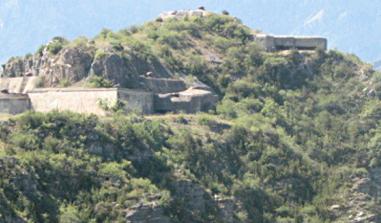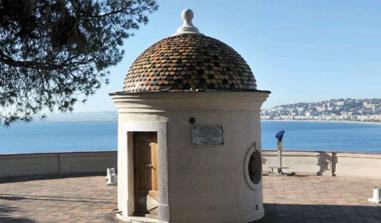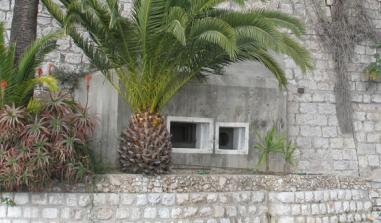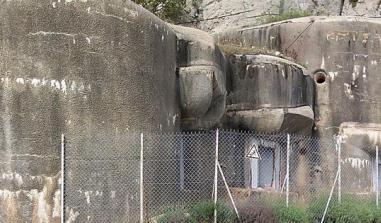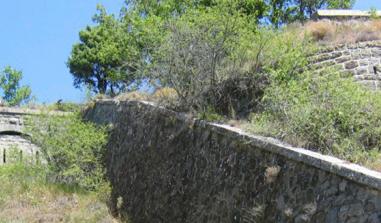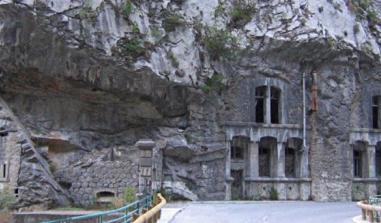Fort des Mille-Fourches
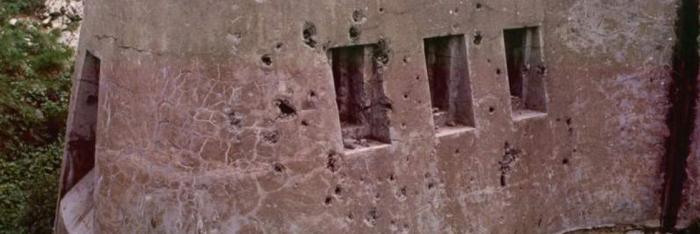
Detail of the two caponniers of the Fort des Mille-Fourches. Source Fortweb.net
The fort des Mille-Fourches was constructed between 1887 and 1890. It operated in conjunction with the fort de la Forca, of which it is a copy. The Redoubt of les Trois Communes, built later, protects them both.
The fort des Mille-Fourches was constructed between 1887 and 1890. It operated in conjunction with the fort de la Forca, of which it is a copy. The Redoubt of les Trois Communes, built later, protects them both.
Its construction was brought about as a result of the Treaty of Turin of 1860. The Savoie and Nice had become part of France once more. The Valley of the Roya, a communications route running north to south in the heart of the Alpine mountain range, was shared between France and Italy. Sealing off the new border had thus become a strategic matter of utmost importance. The military defeat of 1870 forced the complete reorganisation of national defences: reforms within the system of command, the general staff and the armed services and the redefining of the military constituencies into eighteen military regions. All these initiatives were designed to help in preparing to reverse territorial losses and avenge the insult of losing the Alsace-Lorraine. The northeastern border was the subject of all the attention. However, General Seré de Rivières was aware of developments in Franco-Italian relations.
The redoubt of les Trois Communes, built later, protected them. It reflected the rise in tensions between France and Italy and technological developments in particular, such as the "torpedo shell crisis", which rendered some of the Séré de Rivières system obsolete. New projectiles came in the form of cylindrical warheads, which exploded in the open air, with steel replacing cast iron; the new mixes of explosives were more powerful and no longer created smoke; canons (Bange 155 mm and 220 mm) could fire further. Armour plating and surface stonework could therefore be pierced and obstacles on the ground (moats and parapets, caponniers etc.) shattered. The fort des Mille-Fourches belongs to the first generation of the Séré de Rivières system. A belt of forts, built upon natural obstacles at a distance of a few kilometres, provided a range of artillery cover to protect a town (or central nucleus) from 6 kilometres to the rear from enemy bombardment. Le Mille-Fourches is a small fort with a façade with very few openings. It is surrounded by a moat and flanked by concrete caponniers. The internal courtyard was replaced by a vaulted chamber.
With Mussolini's rise to power and the deterioration of Franco-Italian relations, the Authion became a fortified mountain range. The construction in 1929 of a cable car linking the road from Moulinet to Turini and the camp at Cabanes Vieilles made it easier to get supplies to troops all year round. As part of Maginot's programme, the forts of Plan Caval, Raus, la Béole and la Déa were under construction from 1933 onwards. The group was part of the fortified section of the Alpes-Maritimes département (secteur fortifié des Alpes-Maritimes or S.F.A.M.). On the 10th June 1940, Italy declared war on France (Mussolini was hoping to annex Nice and the Savoie). The Italian offensive took place from the 20th to the 25th June. On the 25th June, the armistice was signed. The Alpes-Maritimes was part of the free zone, with the exception of Menton and part of the towns of Isola and Fontan.
In 1942, following the allied landings in North Africa, the Alpes-Maritimes was occupied by the Italians. They were replaced by the Germans in 1943. After the allied landings of the 15th August 1944 at Dramont in the Var, most of the département was liberated on the 6th September, although the high valley of la Roya and the Authion mountain range were still occupied by the Germans who rebuilt the fortifications. General de Gaulle wanted Tende and La Brigue to become part of France again. He hoped to force the hands of the Allies who were quite hostile to any changes to the borders. So, in Nice on the 9th April 1945, he announced the offensive on the Authion and la Roya. Operation "Canard" (Duck) began on the 10th April. On the 12th April, the French took the Authion. French sovereignty over these former Italian territories was recognised by the Treaty of Paris.
Belvédère Tourist Information office: + 33 (0) 4 93 03 41 23 Saint-Martin de la Vésubie Tourist centre: + 33 (0) 4 93 03 21 28 Access The D 2566 via the Turini pass, towards the resort of Camp d'argent and then Authion. Car park in les Trois Communes On foot from les Trois Communes car park
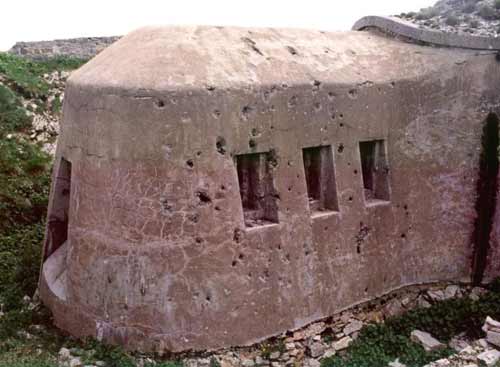
Detail of the two caponniers of the Fort des Mille-Fourches. Source Fortweb.net
Practical information
6540
Saorge
04 93 03 21 28



